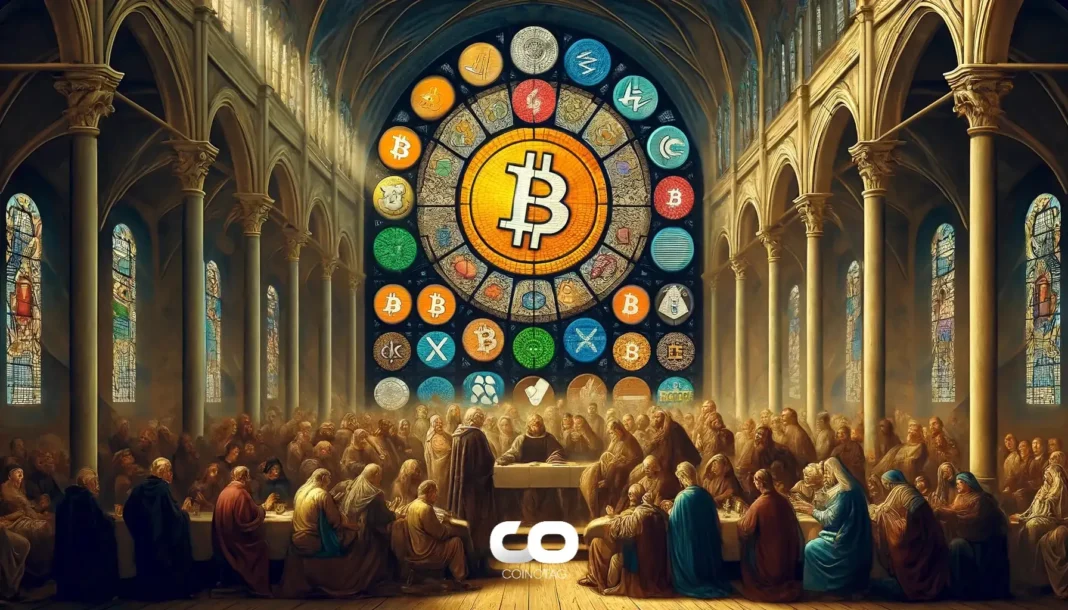| COINOTAG recommends • Exchange signup |
| 💹 Trade with pro tools |
| Fast execution, robust charts, clean risk controls. |
| 👉 Open account → |
| COINOTAG recommends • Exchange signup |
| 🚀 Smooth orders, clear control |
| Advanced order types and market depth in one view. |
| 👉 Create account → |
| COINOTAG recommends • Exchange signup |
| 📈 Clarity in volatile markets |
| Plan entries & exits, manage positions with discipline. |
| 👉 Sign up → |
| COINOTAG recommends • Exchange signup |
| ⚡ Speed, depth, reliability |
| Execute confidently when timing matters. |
| 👉 Open account → |
| COINOTAG recommends • Exchange signup |
| 🧭 A focused workflow for traders |
| Alerts, watchlists, and a repeatable process. |
| 👉 Get started → |
| COINOTAG recommends • Exchange signup |
| ✅ Data‑driven decisions |
| Focus on process—not noise. |
| 👉 Sign up → |
Bitcoin’s recent drop in implied volatility combined with strong holding behavior from short-term investors signals a likely price rise, suggesting a powerful rally may be imminent.
-
Bitcoin’s implied volatility index recently hit its lowest point since September 2023, historically preceding major price rallies.
-
Short-term holders are holding steady, indicating growing market confidence and reduced speculative selling pressure.
-
The Short-Term Holder MVRV ratio at 1.19 suggests a healthier market base, with less risk of immediate profit-taking.
Bitcoin’s low implied volatility and strong short-term holder conviction signal a potential price rise. Stay informed with COINOTAG’s expert market insights.
| COINOTAG recommends • Professional traders group |
| 💎 Join a professional trading community |
| Work with senior traders, research‑backed setups, and risk‑first frameworks. |
| 👉 Join the group → |
| COINOTAG recommends • Professional traders group |
| 📊 Transparent performance, real process |
| Spot strategies with documented months of triple‑digit runs during strong trends; futures plans use defined R:R and sizing. |
| 👉 Get access → |
| COINOTAG recommends • Professional traders group |
| 🧭 Research → Plan → Execute |
| Daily levels, watchlists, and post‑trade reviews to build consistency. |
| 👉 Join now → |
| COINOTAG recommends • Professional traders group |
| 🛡️ Risk comes first |
| Sizing methods, invalidation rules, and R‑multiples baked into every plan. |
| 👉 Start today → |
| COINOTAG recommends • Professional traders group |
| 🧠 Learn the “why” behind each trade |
| Live breakdowns, playbooks, and framework‑first education. |
| 👉 Join the group → |
| COINOTAG recommends • Professional traders group |
| 🚀 Insider • APEX • INNER CIRCLE |
| Choose the depth you need—tools, coaching, and member rooms. |
| 👉 Explore tiers → |
Why Low Implied Volatility Points to a Bitcoin Price Rise
Implied volatility measures expected future price fluctuations and is crucial for anticipating Bitcoin’s market moves. When this metric falls to low levels, as it did recently, it often signals a consolidation phase where the market accumulates energy before a breakout. Historically, Bitcoin’s implied volatility lows have preceded significant upward price movements, making this a key indicator for investors.
Historical Patterns of Bitcoin’s Implied Volatility
In September 2023, Bitcoin’s implied volatility index reached a similar low, followed by a nearly 50% price surge from around $26,000. Since late 2022, whenever the index closed below 45, Bitcoin showed a strong tendency to rally. This pattern suggests that current low volatility levels could herald another significant price rise.
| COINOTAG recommends • Exchange signup |
| 📈 Clear interface, precise orders |
| Sharp entries & exits with actionable alerts. |
| 👉 Create free account → |
| COINOTAG recommends • Exchange signup |
| 🧠 Smarter tools. Better decisions. |
| Depth analytics and risk features in one view. |
| 👉 Sign up → |
| COINOTAG recommends • Exchange signup |
| 🎯 Take control of entries & exits |
| Set alerts, define stops, execute consistently. |
| 👉 Open account → |
| COINOTAG recommends • Exchange signup |
| 🛠️ From idea to execution |
| Turn setups into plans with practical order types. |
| 👉 Join now → |
| COINOTAG recommends • Exchange signup |
| 📋 Trade your plan |
| Watchlists and routing that support focus. |
| 👉 Get started → |
| COINOTAG recommends • Exchange signup |
| 📊 Precision without the noise |
| Data‑first workflows for active traders. |
| 👉 Sign up → |

How Short-Term Holder Behavior Supports a Bitcoin Price Rise
Short-term holders (STHs), who hold Bitcoin for less than 155 days, are currently demonstrating strong conviction by holding rather than selling. This behavior indicates confidence in future price appreciation, reducing the likelihood of immediate sell-offs and supporting a bullish market outlook.
| COINOTAG recommends • Traders club |
| ⚡ Futures with discipline |
| Defined R:R, pre‑set invalidation, execution checklists. |
| 👉 Join the club → |
| COINOTAG recommends • Traders club |
| 🎯 Spot strategies that compound |
| Momentum & accumulation frameworks managed with clear risk. |
| 👉 Get access → |
| COINOTAG recommends • Traders club |
| 🏛️ APEX tier for serious traders |
| Deep dives, analyst Q&A, and accountability sprints. |
| 👉 Explore APEX → |
| COINOTAG recommends • Traders club |
| 📈 Real‑time market structure |
| Key levels, liquidity zones, and actionable context. |
| 👉 Join now → |
| COINOTAG recommends • Traders club |
| 🔔 Smart alerts, not noise |
| Context‑rich notifications tied to plans and risk—never hype. |
| 👉 Get access → |
| COINOTAG recommends • Traders club |
| 🤝 Peer review & coaching |
| Hands‑on feedback that sharpens execution and risk control. |
| 👉 Join the club → |
Understanding the Short-Term Holder MVRV Ratio
The STH MVRV ratio compares the market value of Bitcoin held by short-term investors to their acquisition cost. Currently at 1.19, below the November 2024 peak of 1.33, this ratio signals reduced speculative risk-taking and a more resilient holder base. This environment fosters sustainable growth and supports the potential for a Bitcoin price rise.
What Historical Data Reveals About Market Calm and Bitcoin Price Moves
| Period of Low Volatility |
Market Conditions Pre-Rally |
Bitcoin Price Action Following |
| September 2023 |
Reduced trading volume, investor indecision |
~50% surge from $26,000 within weeks |
| Late 2022 |
Post-bear market accumulation, reduced fear |
Consistent upward movements over months |
| Various consolidation periods |
Price discovery slows, market re-evaluates |
Major breakouts from established ranges |
These trends illustrate that periods of low volatility often serve as precursors to significant Bitcoin rallies, reflecting market cycles of contraction and expansion.
How to Prepare Your Portfolio for a Potential Bitcoin Price Rise
Investors should monitor key indicators like the Bitcoin Implied Volatility Index and the STH MVRV ratio to time entry points effectively. Periods of low volatility combined with strong holder conviction can offer opportune moments to increase Bitcoin exposure, using strategies such as dollar-cost averaging to manage risk.
Key Actionable Insights
- Monitor Market Metrics: Track implied volatility and STH MVRV for early signals of price shifts.
- Reassess Investment Strategy: Consider adding to Bitcoin holdings during consolidation phases aligned with strong holder sentiment.
- Maintain a Long-Term View: Focus on Bitcoin’s fundamental value and growth potential beyond short-term volatility.
- Diversify and Manage Risk: Balance your portfolio to mitigate external market uncertainties.
What Does the Future Hold for Bitcoin’s Price?
The current combination of low implied volatility and confident short-term holders sets the stage for a potential Bitcoin price rise. This market environment resembles a coiled spring ready to release energy, supported by a resilient investor base. While no outcome is guaranteed, historical data and current metrics suggest a strong probability of an upcoming rally.
| COINOTAG recommends • Exchange signup |
| 📈 Clear control for futures |
| Sizing, stops, and scenario planning tools. |
| 👉 Open futures account → |
| COINOTAG recommends • Exchange signup |
| 🧩 Structure your futures trades |
| Define entries & exits with advanced orders. |
| 👉 Sign up → |
| COINOTAG recommends • Exchange signup |
| 🛡️ Control volatility |
| Automate alerts and manage positions with discipline. |
| 👉 Get started → |
| COINOTAG recommends • Exchange signup |
| ⚙️ Execution you can rely on |
| Fast routing and meaningful depth insights. |
| 👉 Create account → |
| COINOTAG recommends • Exchange signup |
| 📒 Plan. Execute. Review. |
| Frameworks for consistent decision‑making. |
| 👉 Join now → |
| COINOTAG recommends • Exchange signup |
| 🧩 Choose clarity over complexity |
| Actionable, pro‑grade tools—no fluff. |
| 👉 Open account → |
Conclusion
Bitcoin’s recent market signals, including historically low implied volatility and solid short-term holder conviction, point toward a likely price rise. Investors should stay vigilant, leveraging these insights to navigate the evolving landscape and position themselves for potential gains in the digital asset’s next growth phase.
| COINOTAG recommends • Members‑only research |
| 📌 Curated setups, clearly explained |
| Entry, invalidation, targets, and R:R defined before execution. |
| 👉 Get access → |
| COINOTAG recommends • Members‑only research |
| 🧠 Data‑led decision making |
| Technical + flow + context synthesized into actionable plans. |
| 👉 Join now → |
| COINOTAG recommends • Members‑only research |
| 🧱 Consistency over hype |
| Repeatable rules, realistic expectations, and a calmer mindset. |
| 👉 Get access → |
| COINOTAG recommends • Members‑only research |
| 🕒 Patience is an edge |
| Wait for confirmation and manage risk with checklists. |
| 👉 Join now → |
| COINOTAG recommends • Members‑only research |
| 💼 Professional mentorship |
| Guidance from seasoned traders and structured feedback loops. |
| 👉 Get access → |
| COINOTAG recommends • Members‑only research |
| 🧮 Track • Review • Improve |
| Documented PnL tracking and post‑mortems to accelerate learning. |
| 👉 Join now → |
Frequently Asked Questions
What is implied volatility and why is it important for Bitcoin?
Implied volatility measures expected future price swings. For Bitcoin, low implied volatility typically signals a consolidation phase before a major price move, often an upward rally.
How does the Short-Term Holder MVRV ratio indicate market sentiment?
The STH MVRV ratio compares short-term holders’ market value to their acquisition cost. A lower ratio means less speculative selling and stronger holding conviction, indicating bullish sentiment.
| COINOTAG recommends • Exchange signup |
| 🎯 Focus on process over noise |
| Plan trades, size positions, execute consistently. |
| 👉 Sign up → |
| COINOTAG recommends • Exchange signup |
| 🛠️ Simplify execution |
| Keep decisions clear with practical controls. |
| 👉 Get started → |
| COINOTAG recommends • Exchange signup |
| 📊 Make data your edge |
| Use depth and alerts to avoid guesswork. |
| 👉 Open account → |
| COINOTAG recommends • Exchange signup |
| 🧭 Be prepared, not reactive |
| Turn setups into rules before you trade. |
| 👉 Create account → |
| COINOTAG recommends • Exchange signup |
| ✍️ Plan first, then act |
| Entries, exits, and reviews that fit your routine. |
| 👉 Join now → |
| COINOTAG recommends • Exchange signup |
| 🧩 Consistency beats intensity |
| Small, repeatable steps win the long run. |
| 👉 Sign up → |
What happened the last time Bitcoin’s implied volatility was this low?
Bitcoin’s implied volatility was similarly low in September 2023, followed by a nearly 50% price increase from about $26,000, showing a strong historical correlation.
Are there any risks to consider despite these bullish signals for Bitcoin?
Yes, factors like economic events, regulations, and institutional activity can affect prices. Investors should conduct research and manage risks carefully.
| COINOTAG recommends • Premium trading community |
| 🏛️ WAGMI CAPITAL — Premium Trading Community |
| Strategic insights, exclusive opportunities, professional support. |
| 👉 Join WAGMI CAPITAL → |
| COINOTAG recommends • Premium trading community |
| 💬 Inner Circle access |
| See members share real‑time PnL and execution notes in chat. |
| 👉 Apply for Inner Circle → |
| COINOTAG recommends • Premium trading community |
| 🧩 Turn theses into trades |
| Reusable templates for entries, risk, and review—end to end. |
| 👉 Join the club → |
| COINOTAG recommends • Premium trading community |
| 💡 Long‑term mindset |
| Patience and discipline over noise; a process that compounds. |
| 👉 Get started → |
| COINOTAG recommends • Premium trading community |
| 📚 Education + execution |
| Courses, playbooks, and live market walkthroughs—learn by doing. |
| 👉 Get access → |
| COINOTAG recommends • Premium trading community |
| 🔒 Members‑only research drops |
| Curated analyses and private briefings—quality over quantity. |
| 👉 Join WAGMI CAPITAL → |
How long do these low volatility periods usually last before a rally?
Duration varies widely. While low volatility often precedes rallies, exact timing is uncertain. Monitoring market signals is essential for timing.
| COINOTAG recommends • Exchange signup |
| 🧱 Execute with discipline |
| Watchlists, alerts, and flexible order control. |
| 👉 Sign up → |
| COINOTAG recommends • Exchange signup |
| 🧩 Keep your strategy simple |
| Clear rules and repeatable steps. |
| 👉 Open account → |
| COINOTAG recommends • Exchange signup |
| 🧠 Stay objective |
| Let data—not emotion—drive actions. |
| 👉 Get started → |
| COINOTAG recommends • Exchange signup |
| ⏱️ Trade when it makes sense |
| Your plan sets the timing—not the feed. |
| 👉 Join now → |
| COINOTAG recommends • Exchange signup |
| 🌿 A calm plan for busy markets |
| Set size and stops first, then execute. |
| 👉 Create account → |
| COINOTAG recommends • Exchange signup |
| 🧱 Your framework. Your rules. |
| Design entries/exits that fit your routine. |
| 👉 Sign up → |
Key Takeaways
- Low implied volatility often signals Bitcoin is consolidating before a major price rise.
- Short-term holders’ strong conviction reduces speculative selling, supporting bullish momentum.
- Historical data shows consistent rallies following periods of low volatility.
- Monitoring key metrics like implied volatility and STH MVRV ratio helps anticipate market shifts.
- Risk management and diversification remain essential despite bullish indicators.
Conclusion
Bitcoin’s current market conditions, marked by historically low implied volatility and confident short-term holders, suggest a potential price rise is on the horizon. These indicators, supported by strong historical precedents, offer investors valuable insights to navigate the market strategically. Remaining informed and cautious will be key as Bitcoin’s next major rally potentially unfolds.
| COINOTAG recommends • Members‑only research |
| 📌 Curated setups, clearly explained |
| Entry, invalidation, targets, and R:R defined before execution. |
| 👉 Get access → |
| COINOTAG recommends • Members‑only research |
| 🧠 Data‑led decision making |
| Technical + flow + context synthesized into actionable plans. |
| 👉 Join now → |
| COINOTAG recommends • Members‑only research |
| 🧱 Consistency over hype |
| Repeatable rules, realistic expectations, and a calmer mindset. |
| 👉 Get access → |
| COINOTAG recommends • Members‑only research |
| 🕒 Patience is an edge |
| Wait for confirmation and manage risk with checklists. |
| 👉 Join now → |
| COINOTAG recommends • Members‑only research |
| 💼 Professional mentorship |
| Guidance from seasoned traders and structured feedback loops. |
| 👉 Get access → |
| COINOTAG recommends • Members‑only research |
| 🧮 Track • Review • Improve |
| Documented PnL tracking and post‑mortems to accelerate learning. |
| 👉 Join now → |








